Boeing B-52H Stratofortress 60-0007 of the 23rdBS/5thBW, which is based at Minot AFB, North Dakota.
The 2019 Australian International Airshow and Aerospace & Defence Exposition held at Avalon Airport near Geelong in Victoria, is the 14th time the show has been held since its inception back in October 1992. This biennial show is one of the Asia-Pacific regions most prestigious and the largest of its kind in the southern hemisphere. This airshow, like the ones before has something for everyone, from aerospace industry professionals, the military, aviation enthusiasts, recreational pilots and the general public, there are attractions and displays to cater for the most discerning of interests.
United States Air Force
The United States Air Force are no strangers to the Australian International Airshow held at Avalon Airport, with their involvement stretching back to the first show that was staged in October of 1992. The USAF has always provided a varied assortment of aircraft types from their fleet over the years to participate as either part of the flying display, or as a static exhibit. One aircraft in particular that gets the hearts racing of many an aviation enthusiast is the legendary Boeing B-52H Stratofortress. This iconic aircraft has visited Avalon on many occasions since its first appearance as a static bird during the 1999 Australian International Airshow.
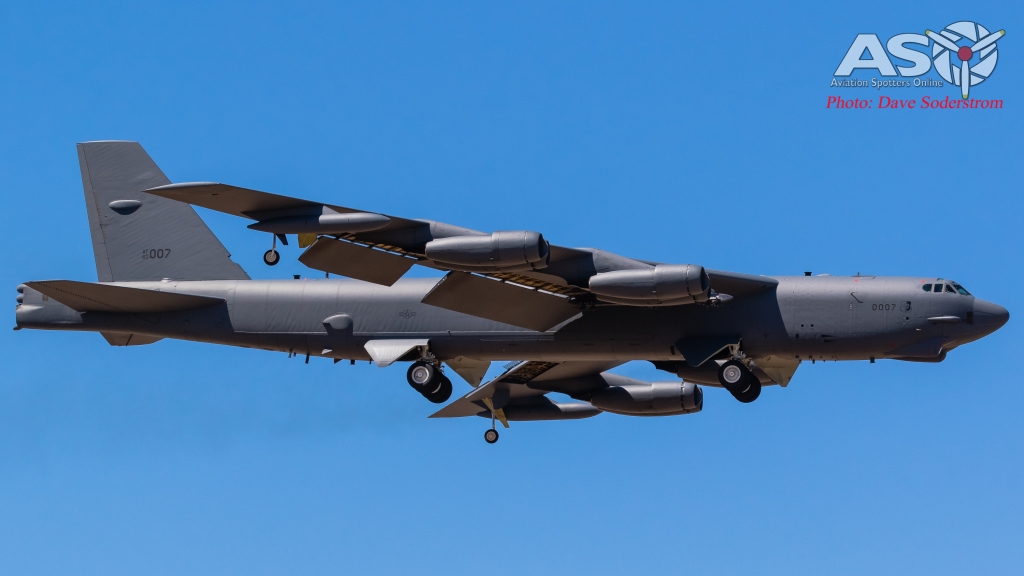
B-52H ‘BUFF’ arrival onto Avalon’s main runway in preparation for the start of the 2019 Australian International Airshow.
Boeing B-52 Stratofortress – A Brief History.
” The long rifle was the great weapon of its day… today this B-52 is the long rifle of the air age”
– Air Force Chief of Staff Nathan Twining, during B-52B roll out ceremony – March 18 1954.
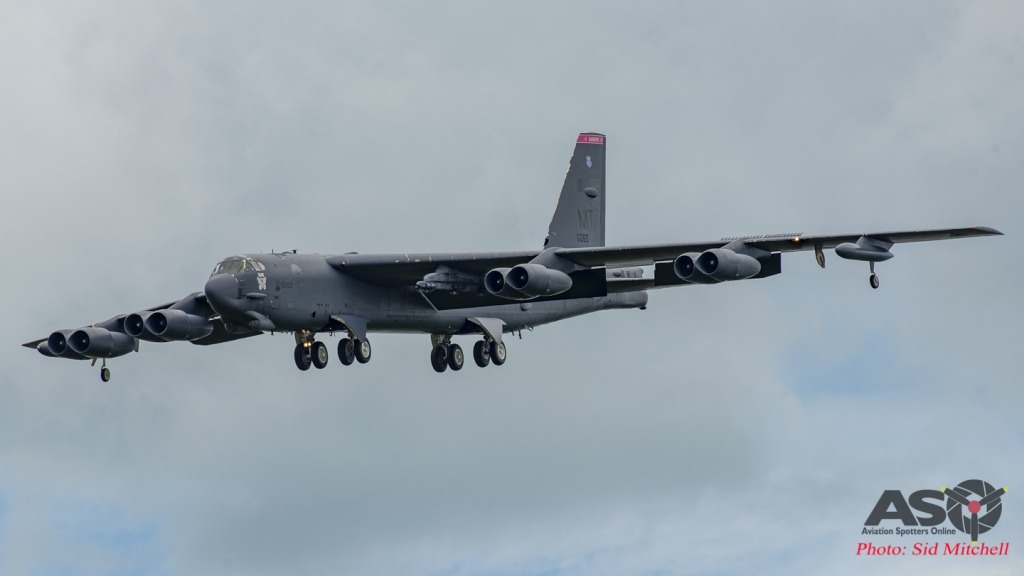
USAF B-52H 60-0060 ‘Iron Butterfly’ from the “Barons” – the 23d Bomb Squadron, 5th Bomb Wing, Minot AFB, Nth Dakota
The mighty Boeing B-52 Stratofortress has been the mainstay, long range, jet powered stategic bomber of the United States Air Force since it’s introduction into active service with the Strategic Air Command (SAC) in 1955. After SAC was disbanded in 1992, all remaining aircraft were transferred to Air Combat Command (ACC), with 2010 witnessing ACC absorbed into the newly created Air Force Global Strike Command (AFGSC). Since January 2016 there were 58 B-52’s in active service with up to 18 airframes in reserve. With a weapons payload of up to 32,000kg, and typical combat range exceeding 14,000km without the need for aerial refueling, the B-52 or BUFF, ( Big Ugly Fat F**ker), as it’s more affectionately known, is expected to serve until the early 2050’s.
Development-
Conceived on the 23rd November 1945 after the Air Materiel Command issued a directive with performance criteria for a new strategic bomber that was “capable of carrying out the strategic mission without dependence upon advanced and intermediate bases controlled by other countries”. Requirements issued stated the aircraft be crewed with no fewer than five turret gunners, with a six man crew, cruise at – 380km/h at 34,000 feet with a combat radius of 8,000km. Armament was to consist of unspecified 20mm cannon and 4,500kg of bombs. February 1946 saw the Air Force issue bid invitations for the design and building to these specifications, with Boeing, Consolidated Aircraft, and Glenn L. Martin Company submitting desired proposals. In June 1946, Boeing offered its proposed bomber, the Model 462, a straight winged aircraft powered by six turboprops, that had a total gross weight of 160,000kg, and a combat radius of up to 5,000km, which was announced as the winning design. Although these figures looked impressive on paper, it wasn’t until a full scale mock-up of the proposed design for engineering and testing was built, that concerns were raised over it’s sheer size and its ability to meet Air force requirements.

USAF B-52H 60-0055 ‘War Eagle’ from the “Barons” – the 23d Bomb Squadron, 5th Bomb Wing, Minot AFB, Nth Dakota.
Over the next two years, the first proposal which was the Model 462, had now evolved into the Model 464 by which time was becoming a very different aircraft than what was originally planned. With the Model 464-17 meeting most requirements bar range, and with the nuclear role added, doubts were cast as to whether this would provide any improvement over the current bomber, the Convair B-36, and by the time it entered full scale production, it would itself be, obsolete. With the resulting decision to put the project on hold for a six month period, and during this time the overall requirements for the program where once again changed, Boeing continued with test and development of their current technologies, which also included exploring current innovations, such as Northrops YB-49 jet powered flying wing, and aerial refueling. After Boeing had regained the bid to stave off cancellation of the contract, the revised requirements called for an aircraft with a top speed of – 825km/h at 35,000 feet, with a range of 11,000km and 125,000kg gross weight which included 4,500kg of bombs and 75,225 litres of fuel.

The BUFF has gained many improvements and updates since 1955, as is evident with this B-52H of 2019.
XB-52 Design-
May 1948 saw Boeing incorporate the Westinghouse J-40 jet engine into the design, which resulted in yet another revision, and again, doubts raised by the government about its overall range, as the jet engine had by this time not progressed enough to warrant a design based solely on jet propulsion, with the turboprop still being the favored choice. October 1948 was a crucial month in the design of the XB-52 with Boeing engineers asked by the chief of bomber development Colonel Pete Warden, to come up with a design for a four engine turbojet bomber. The new design was loosely based on the layout of the Boeing B-47 Stratojet that incorporated a 35 degree swept-wing, eight engines paired in four underwing pods, and with bicycle landing gear along with wingtip outriggers. A point of interest with the landing gear design is its ability to pivot up to 20 degrees to allow crosswind landings whilst keeping the aircraft aligned on the runway centreline. By April 1949 a full scale mock up was presented for inspection, with concerns about range still a concern due to the J-40 and J-57 jet engines then available, the then newly appointed head of Strategic Air Command General Curtis Le May, insisted performance not be compromised due to engine development delays. General Le May also asked for the design be changed from the B-47 style tandem seating arrangement, to the conventional side by side seating, which increases crew efficiency and lowers crew fatigue. Boeing was awarded the contract on February 13 1951 for thirteen B-52A models, and seventeen detachable reconnaissance pods.
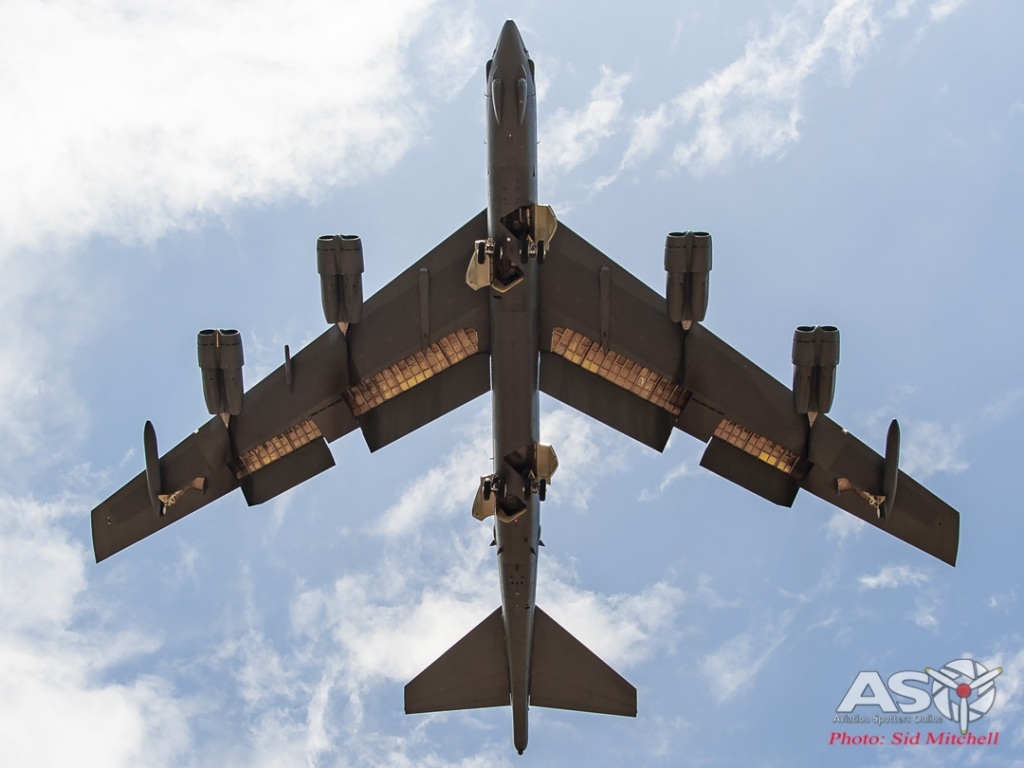
USAF B-52H 60-0005 “Warbirds” from the “Barons” – the 23d Bomb Squadron, 5th Bomb Wing, Minot AFB. Commander’s a/c – Colonel Bradley Cochran May 2018–Present, Commander, 5th Bomb Wing, Minot AFB, N.D.
Production –
The YB-52, the second of the two XB-52’s built, and the first operationally modified, took to the air on its first flight on April 15 1952 with legendary Boeing test pilot ‘Tex’ Johnston at the controls, which culminated with a successful 2 hour and 21 minute sortie, which preceded 670 days of wind tunnel, and 130 days of aerodynamic and aeroelastic testing that paid off with the U.S Air Force increasing the order to 282 B-52’s. Of the original 13 B-52A’s ordered, only three were built, with the remaining ten returned to Boeing to be completed and enter service as B-52B models. Following on from the B-52B, the B-52 progressed along steadily with different variants up until the B-52G, and turbofan B-52H. With production schedules at full rate, Boeing where producing at both their Seattle and Wichita facilities, with a staggering 5,000 companies involved with its manufacture, including 41% built by sub-contractors. Seattle, due to its location had strict curfews in regards to aircraft noise, so once aircraft needed testing, they ferried to Larson Air Force Base (240km east) for full testing. Production rates at both plants are as follows-
Seattle – Wichita –
*Prototype- 3 *B-52D – 69
*B-52A – 3 *B-52E – 58
*B-52B – 50 *B-52F – 45
*B-52C – 35 *B-52G – 193
*B-52D – 101 *B-52H – 102
*B-52E – 42
*B-52F – 44
Between 1954 and 1963, a culminative total of 742 airframes had been produced at both Seattle & Wichita plants.

USAF B-52H 60-0055 ‘War Eagle’ from the “Barons” – the 23d Bomb Squadron, 5th Bomb Wing, Minot AFB, Nth Dakota.
Operational History –
As noted earlier, the B-52A model never entered operational service, as these aircraft were only used in testing. The B-52B was the first to enter operational service, with aircraft 52-8711 having the honour of doing so with the 93rd Heavy Bombardment Wing (93rdBW) at Castle Air Force Base, California, June 29 1955, with the Wing becoming operational the following March. Castle AFB was home to the Convair B-36 and where replaced on a one to one basis as the B-52’s came online. Training for B-52 crews at Castle consisted of five weeks ground school, with four weeks flying, averaging 35 to 50 hours in the air.
The first air dropped thermonuclear Mk-15 device was dropped by a B-52B (52-0013), in May 1956 over Bikini Atoll during testing that was code named ‘Cherokee’. To demonstrate the B-52’s global reach, three B models made a non-stop record setting flight around the world during January 1957, named ‘Operation Power Flite’, which saw them cover a distance of 39,165km in 45 hours 19 minutes at a speed of 536mph, with in flight refueling performed by Boeing KC-97 Stratofreighters. Other notable feats achieved by the B-52 include –
* B-52D world speed record over 10,000km closed circuit with payload at a speed of 902km/h in September 1958.
*B-52D world speed record over 5,000km closed circuit with payload at a speed of 962 km/h in September 1958.
*B-52G world distance record flying unrefueled for 16,227km lasting 19 hours & 44 minutes, December 1960.
*B-52H that surpassed the previous world distance record of flying un-refueled, flew a staggering 20,177km from Kadena AFB in Japan, to Torrejón Air Base in Spain, during January of 1962.
*B-52H became first US military aircraft to fly using alternative fuel, December 2006.
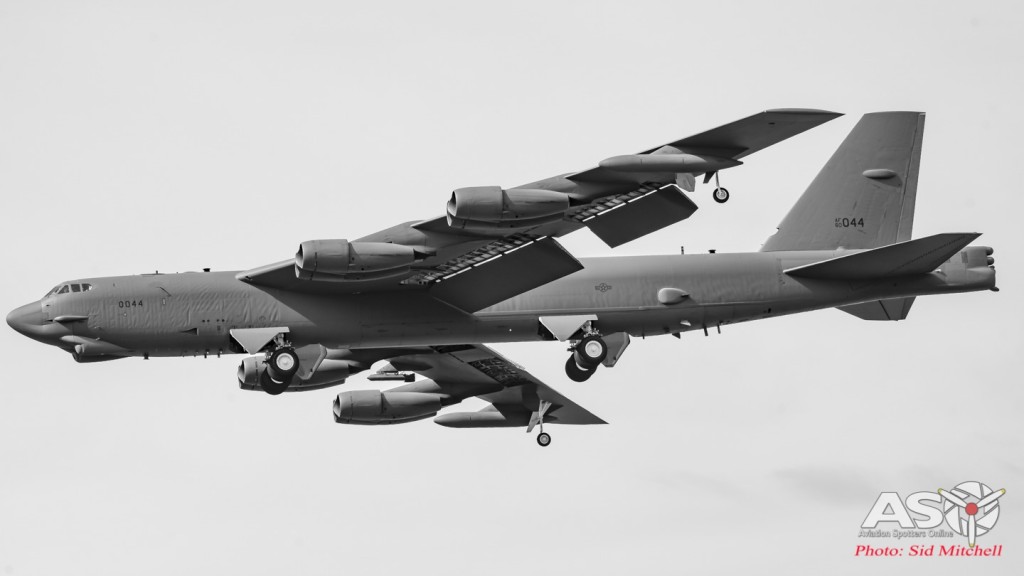
USAF B-52H 60-0044 from the “Barons” – the 23d Bomb Squadron, 5th Bomb Wing, Minot AFB.
Cold War –
Throughout the Cold War, the term ‘Mutually Assured Destruction’ was a concept that both the Soviet Union and the United States knew all too well. The Strategic Air Command(SAC), intended to use the B-52 to counteract any threat thrown at them by the Soviet Union, with their main role being that of a nuclear deterrence. With many airborne patrols flown at high altitude near the Soviet borders that would’ve provided rapid first strike or retaliation capability, some of these patrols where given code names such as ‘Head Start, Chrome Dome, Round Robin and Giant Lance’, to name but a few.
With technological advances moving at a rapid rate during the 1960’s, a new threat emerged with the introduction of the Surface to Air Missile (SAM), that could intercept high flying aircraft such as the B-52. With this, the B-52’s mission from high altitude bombing was changed to that of a low-level penetration bomber, using the terrain to mask its path and avoid radar detection, which reduced the threat of SAM attacks. During this period, concerns over the B-52’s lifespan were raised, with several replacement projects underway such as the Convair B-58 Hustler, and the North American XB-70 Valkyrie. With no viable replacement to succeed the role of the B-52, SAC boss General Curtis E. LeMay was quoted as saying in February of 1965 during a congress hearing that “The B-52 is going to fall apart on us before we can get a replacement for it”. History has shown this not to be the case, with aircraft such as the General Dynamics F-111 later complementing the USAF’s fleet of B-52’s in roles such as high speed, low level penetration missions, a role not generally suited to the B-52.

B-52H 60-0007 23rdBS/5thBW Avalon Airport 2019
Vietnam War –
With tensions escalating in Southeast Asia during the early 1960’s, the United States found itself at war once again. March 1965 saw the commencement of Operation Rolling Thunder, with the first combat mission flown at the time, by converted B-52F’s, named Operation Arc Light. Theses F models were converted and fitted with external bomb racks that could carry up to 24 x 750Ib bombs, that where flown by the 9th and 44th Bombardment Squadrons during the start of the air campaign over Vietnam. The year 1965 also witnessed a number of B-52D’s undergo the ‘Big Belly’ modifications to increase their bomb carrying capacity for carpet bombing, which kept the external capacity at 24 bombs, but increased the internal capacity from 27 to 84 of the 500Ib variety of bomb, and for the larger 750Ib bomb, from 27 to 42 respectively. This modification created enough capacity for 108 bombs weighing in at 27,215kg.
From 1966 the B-52D ‘Big Belly’ bombers were now based out of Anderson AFB in Guam, necessitating in 10-12 hour bombing missions with aerial refueling performed by Boeing KC-135 Stratotankers, which ultimately led to B-52D’s also being based out of U-Tapao Air Base in Thailand from 1967 onwards, that didn’t require air to air refueling. Operation Linebacker II that was conducted between December 18 to 29, 1972, was the bombing campaign that brought the North Vietnamese back to the negotiating table that would ultimately help America pull out of the war in Vietnam. During this period, waves of B-52’s flew 729 sorties over a 12 day period, and dropped up to 15,227 tonnes of ordnance over Hanoi, Haiphong and other critical targets in North Vietnam.
Another fact not widely spoken about are the rear tail gunners who remarkably shot down two Vietnam Peoples Air Force (VPAF ) MiG-21 ‘Fishbeds’ during the war, with their .050 caliber machine guns. These victories make the B-52 one of the largest aircraft to be credited with air to air kills.

USAF B-52H 60-0005 “Warbirds” from the “Barons” – the 23d Bomb Squadron, 5th Bomb Wing, Minot AFB. Commander’s a/c – Colonel Bradley Cochran May 2018–Present, Commander, 5th Bomb Wing, Minot AFB, N.D.
From Vietnam to the Gulf War –
With the end of the Vietnam War, most of the early model B-52’s where retired, or on their way to be, starting with the B-52B in 1966, leaving the pair B models operated by NASA to carry on until replaced by a B-52H, and the E models being retired by 1970, therefore leaving the F models to soldier on until 1973. The B-52D models via the Pacer Plank update program during the 1970’s kept them flying up until 1983.
During this period the attention was thrown onto the G and H models that were on nuclear ‘alert’ duty, required under the United States nuclear triad, a combination of nuclear-armed land based missiles, submarine based missiles and manned bombers. The mid 1980’s saw the introduction of the cancelled Carter government Rockwell B-1 Bomber, which was reinstated during the Reagan era to supplant the B-52, which in the end replaced the older model B-52’s and the supersonic FB-111A. The year 1991 also witnessed the deactivation of the Strategic Air Command and along with it, 24 hour SAC alert duty.
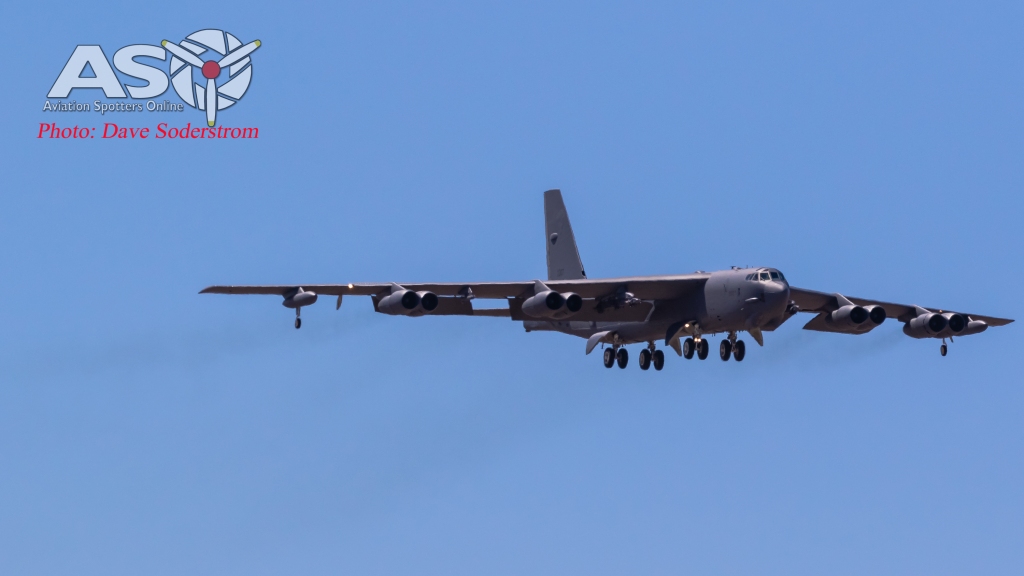
Operation Desert Storm and beyond –
January 16 1991 saw a flight of seven B-52G’s depart Barksdale AFB, Louisiana, on a round robin mission that saw them fly 35 hours and cover a distance of 23,000kms, after hitting targets in Iraq during the opening night of the war. This in itself was a record breaking flight for a long distance combat mission, topping the RAF ‘Black Buck’ mission during the Falklands conflict operating their Vulcan B.2 Bombers in 1982. During Operation Desert Storm, B-52’s flew approximately 1,620 sorties and dropping up to 40% of the total ordnance expended during the conflict. Also during this period the tail gunners position was eliminated, and the gun turrets permanently deactivated.
Since the 1991 Gulf War the B-52G fleet were retired in the mid 1990’s leaving the B-52H as the sole variant left in frontline service, and have been kept busy since, including –
* September 1996 – A pair of B-52H’s conducted a mission over Baghdad as part of Operation Desert Strike, striking power and communication facilities, which saw the bombers fly a 34 hour, 29,740 km round trip that originated from Anderson AFB, Guam, making this the longest distance flown for a combat mission.
* March 1999 – B-52 bombers operating from bases in the UK during Operation Allied Force, which saw the bombing of Serbian targets throughout the Federal Republic of Yugoslavia.
* September 2001 – Operation Enduring Freedom that saw the B-52 provide Close Air Support (CAS) over Afghanistan/Southwest Asia in the fight against the Taliban, with a third of the ordnance expended being dropped by the B-52H’s.
* March 2003 – B-52’s where once again over the skies of Iraq launching approximately 100 AGM-86C Cruise Missiles during Operation Iraqi Freedom.
* April 2016 – A number of B-52’s were noted as operating from Al Udeid Air Base in Qatar, part of the coalition intervention against ISIL as part of Operation Inherent Resolve, also during this timescale, B-52’s arrived in Afghanistan to take part in the War in Afghanistan.
* February 2018 – B-52’s participated in U.S led strikes against pro-government forces in eastern Syria.
As of April 2019, the only active model of the B-52 is the B-52H, that is flown by three wings located at either Barksdale Air Force Base, Louisiana, or Minot Air Force Base, North Dakota.
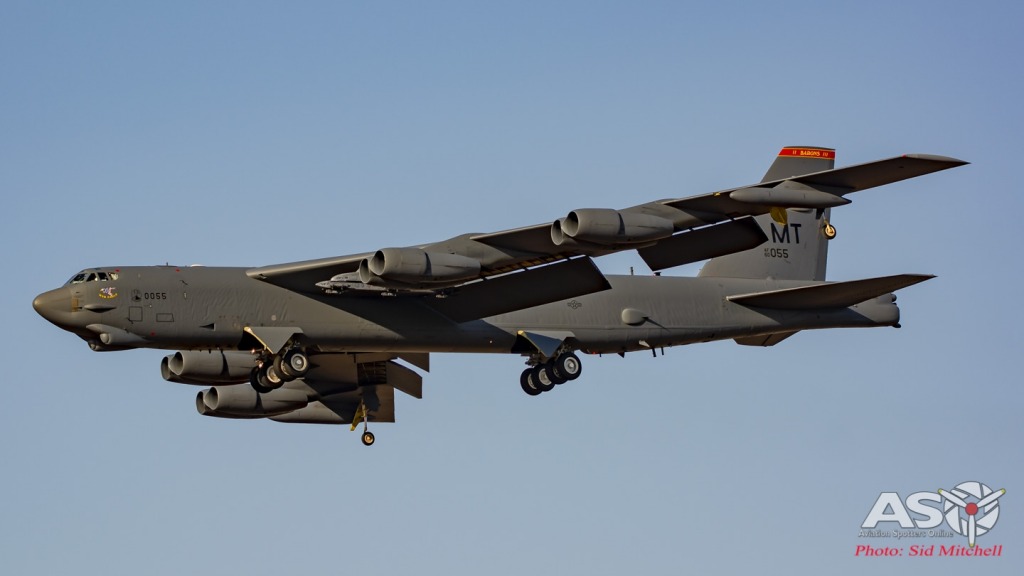
USAF B-52H 60-0055 ‘War Eagle’ from the “Barons” – the 23d Bomb Squadron, 5th Bomb Wing, Minot AFB, Nth Dakota.
* 2nd Bomb Wing – Barksdale AFB, Louisiana.
* 11th Bomb Squadron – ’Jiggs Squadron’ Tail code – LA (Gold fin stripe)
* 20th Bomb Squadron – ‘Buccaneers’ Tail code – LA ( Blue fin stripe)
* 96th Bomb Squadron – ‘ Red Devils’ Tail code – LA ( Red fin stripe)
* 307th Bomb Wing, Air Force Reserve Command (AFRC) – Barksdale AFB, Louisiana.
* 93rd Bomb Squadron – ‘Indian Outlaws’ Tail code – BD ( Blue/Gold Chex fin stripe)
* 343rd Bomb Squadron – Training unit associated with the 2nd Bomb Wing.
* 5th Bomb Wing- Minot Air Force Base, North Dakota.
* 69th Bomb Squadron – ‘ Knighthawks’ Tail code – MT ( Yellow fin stripe)
* 23rd Bomb Squadron – ‘ Barons’ Tail code – MT ( Red fin stripe)
The 2019 Australian International Airshow was this year presented with a 5th Bomb Wing B-52H Stratofortress ( 60-0007, c/n-464372), for the purpose as a static display, appropriate as the 23rd Bomb Squadron is currently on deployment to Anderson Air Force Base in Guam.
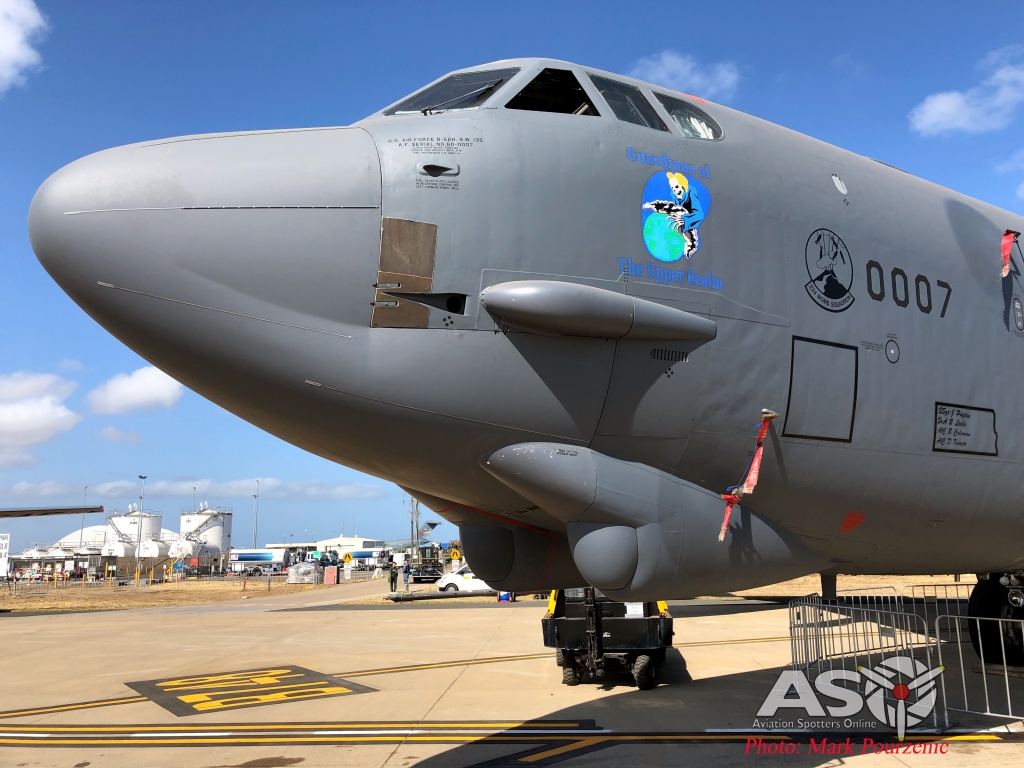
B-52H 60-0007 wearing 5thBW nose art ‘Guardians of The Upper Realm’.
Not only where the gathered crowd treated to a static display of the B-52 on the ground, crowds also had the opportunity to witness the sight and sound of a B-52 in the air during the Friday night show, as another 23rdBS B-52 (60-0060, c/n 464425 ‘Iron Butterfly’), had made the 8 hour flight from Guam to perform its flyover. During its return flight to Anderson AFB, 60-0060 due to a malfunction had to return to Avalon as a safety precaution, and in doing so, creating history, as this was the first time since the Airshow has been held at Avalon Airport that two Boeing B-52H Stratofortress bombers were on the ground at the same time, although if only for a 24 hour period.
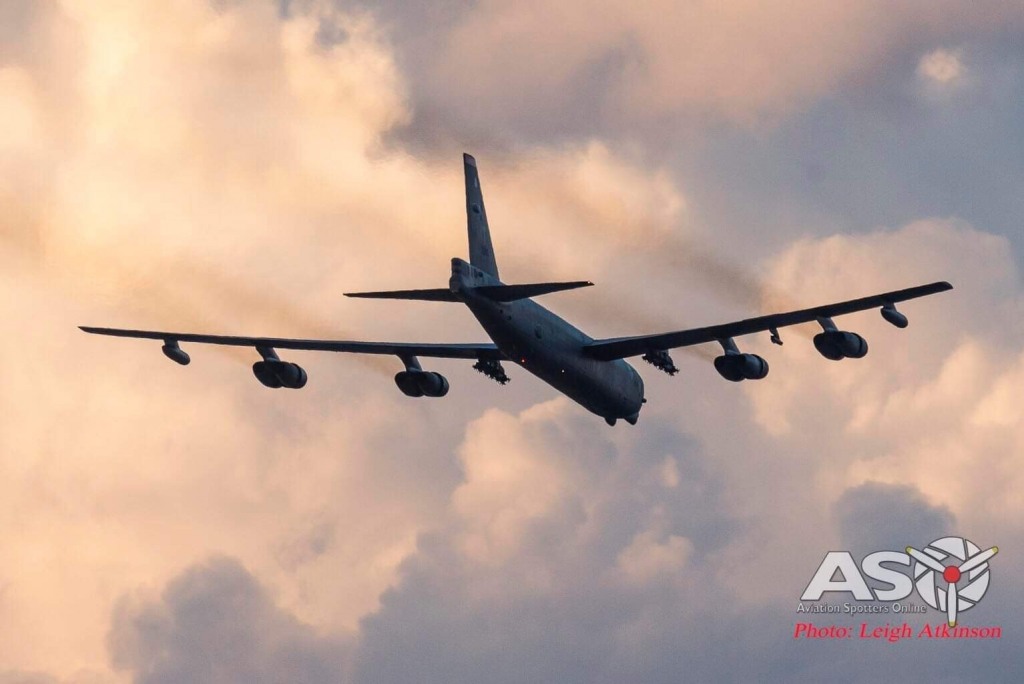
B-52H 60-0060 ‘Iron Butterfly’, overflying Avalon airport during the 2019 Australian International Airshow. Little did many know that within 8 hours, this 23rd Bomb Squadron BUFF would be on the ground.

USAF B-52H 60-0060 ‘Iron Butterfly’ from the “Barons” – the 23d Bomb Squadron, 5th Bomb Wing, Minot AFB, Nth Dakota
5th Bomb Wing – ‘The Warbirds’
Air Force Global Strike Command
Eighth Air Force
Minot Air Force Base – North Dakota
Motto – ” K i a i o k a l e w a ”
Hawaiian : G u a r d i a n s o f t h e U p p e r R e a l m
The 5th Bomb Wing is a major Air Combat Command (ACC) unit that is assigned to Air Force Global Strike Command (AFGSC) under the Eighth Air Force, based at Minot Air Force Base, North Dakota. It along with the 2ndBW based at Barksdale, Louisiana, are the only two B-52 wings within USAF.

Close up of the nose art worn by B-52H 60-0007 ‘Guardians of The Upper Realm’.
The 5thBW is one of the oldest USAF units, and can trace its origins back to the United States Army Air Force, when it was formed at Luke field, on Hawaiian territory during August 1919, as one of the original 15 combat air groups under the then 5th Group (Composite).

In 1935, the 5th Group was instrumental in saving the city of Hilo, Hawaii, when the Mauna Loa volcano erupted. With 10 Keystone B-3 and B-4 bombers that where assigned to the groups 23rd and 72nd bomb squadrons, they dropped a total of 20 x 600 pound (225kg) bombs around the base of the volcano to help divert the lava flow away from the town.
During the outbreak of World War II, the Wing was stationed at Hickam Field, on the island of Oahu, Hawaii. December 7th 1941 saw the 5th Bombardment Group suffer major losses of its B-17 Flying Fortress and B-18 Bolo bombers during the surprise attack by the Japanese at Pearl Harbour, Hawaii, and has been credited as one of the first units back in the air following the attack.
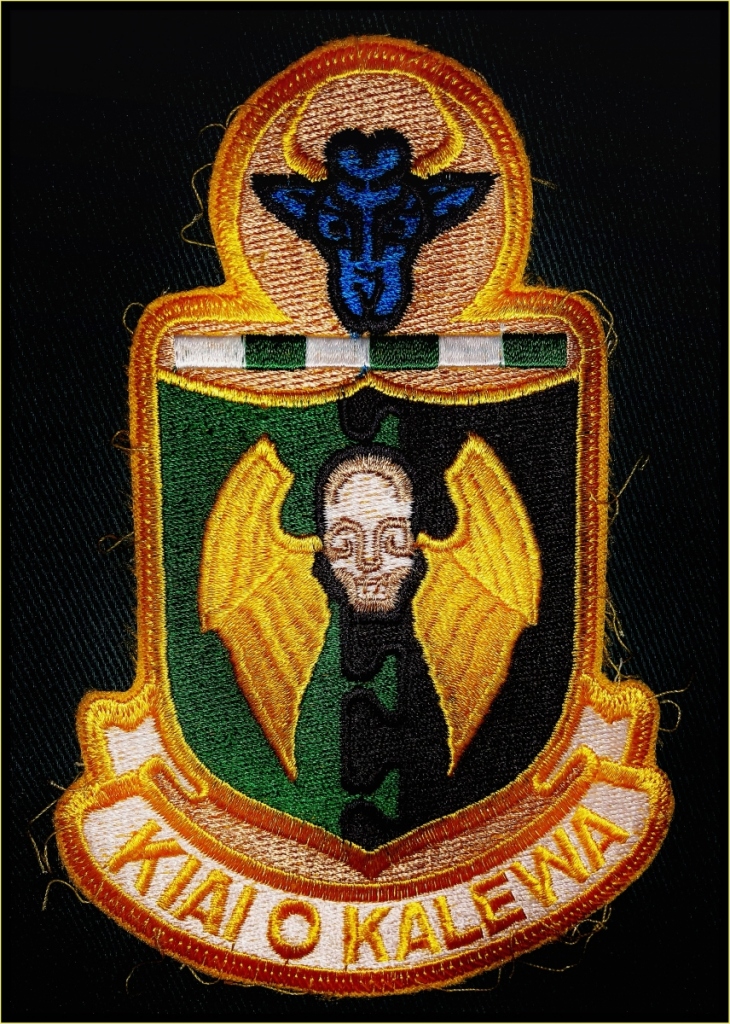
Reproduction patch of the 5th Strategic Bombardment Wing, Heavy emblem, that was approved in 1924 – circa 1950’s.
The Wing was officially established on July 1 1949, as the 5th Strategic Reconnaissance Wing, and activated at Mountain Home AFB, Idaho. 1950 saw it redesignated as the 5th Strategic Reconnaissance Wing, Heavy. 1955 and another revision as the 5th Bombardment Wing, Heavy until 1991, when it was simply known as the 5th Wing, before its final designation as the 5th Bomb Wing in 1992.

Current 5th Bomb Wing emblem, that features a winged death’s head, an uncompromising symbol, for the ‘Guardians of The Upper Realm’.
The 5th Bomb Wing in its current form that is headquartered at Minot AFB, ND, has a fleet of 36 B-52H’s, more than half currently in service, with the 69th and 23rd Bomb Squadrons that are currently operational on type.
23rd Bomb Squadron –
The 23rd Bomb Squadron ‘Barons’, is one of the oldest in the United States Air Force. It was stood up on June 16 1917 at Kelly field in Texas as the 23rd Aero Squadron. During World War 1 it was deployed to England under the American Expeditionary Force as an aircraft repair squadron.
Following the squadrons return from England, they spent the 1920’s and 30’s stationed in Hawaii. During 1935 the units emblem was a creation of what the Squadron is historically famous for, with their involvement during the Mauna Loa volcano eruption, and their help in diverting the lava flow, thus saving the city of Hilo, Hawaii.

Early variation of the 23rd Bomb Squadron emblem, dating back to the 1935 mission to save the city of Hilo, after the eruption of Mauna Loa Volcano, Hawaii.
World War II saw the 23rd under the control of the 5th Bombardment Group and operating the Boeing B-17E Flying Fortress in the Southwest Pacific theatre of operations. During 1943 the Squadron transitioned onto the Consolidated B-24 Liberator Bomber, and with it, long range bombing missions became its forté. The squadron earned the Distinguished Unit Citation on two occasions during the war, the first for the longest over water bomb mission – 1,300 miles (2092km) to the Japanese Base at Woleai island, and the destruction of oil refineries in Borneo during September 1944. The Squadron found itself based in the Philippines at the end of hostilities.
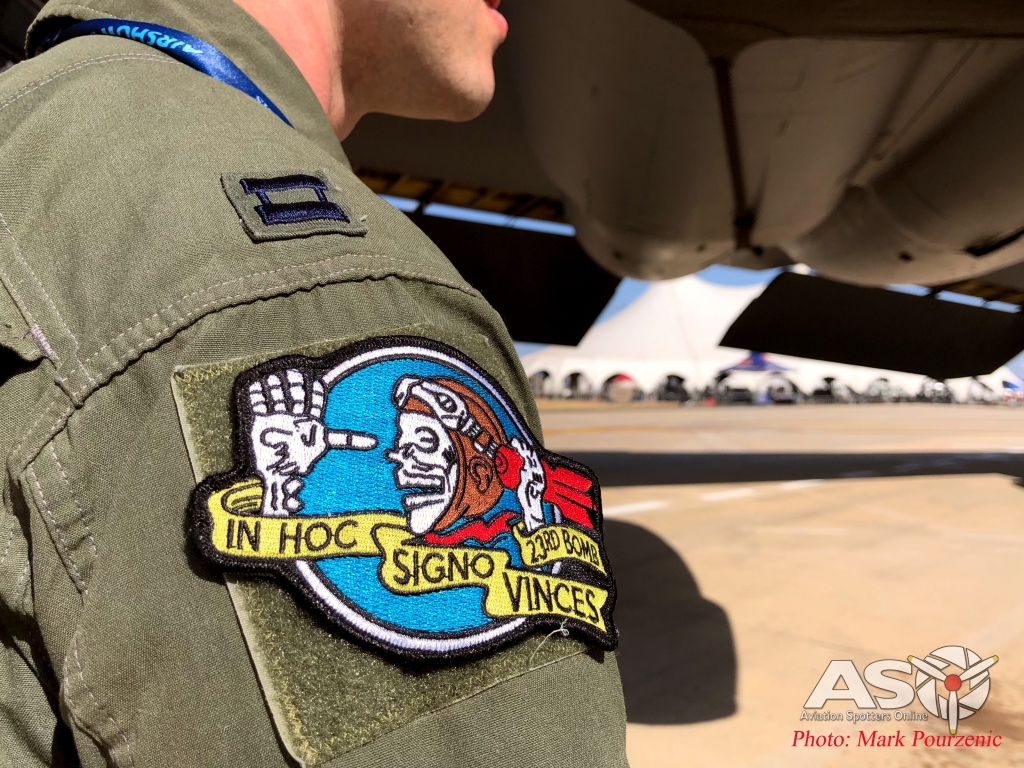
23rd Bomb Squadron Morale patch as worn by the visiting B-52 crew during the 2019 Australian International Airshow. – ‘In Hoc Signo Vinces‘ – Latin translation –“In this sign thou shalt conquer”, literally meaning “in this, conquer”.
During the start of the Cold War, the 23rd Strategic Reconnaissance Squadron relocated to Travis Air Force Base in California during 1949, where it would undertake its new role flying Global Strategic Reconnaissance Missions with their Boeing RB-29 Superfortress bombers during the time period of 1949-1951, with the RB-29’s superseded by the newly introduced Convair RB-36F Peacemakers, one of the largest mass-produced piston engined aircraft ever built, with six props turning and 4 jet engines, they where quite the sight and sound to behold, with 1953 seeing an upgraded version, the RB-36H entering the fray and continuing their current mission until the later half of 1955.
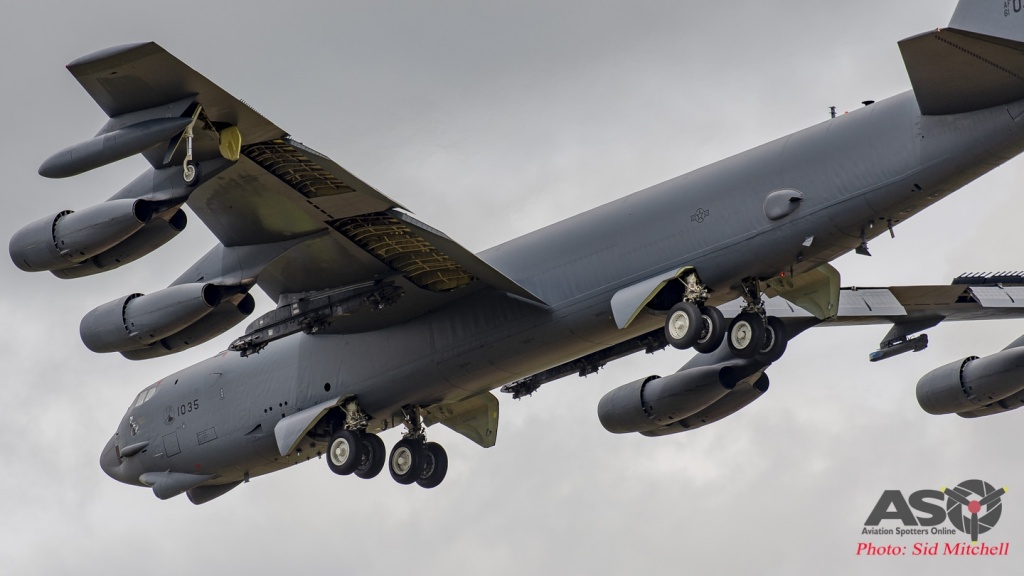
USAF B-52H 61-0035 ‘Witches Brew’ – 23d Bomb Squadron, 5th Bomb Wing, Minot AFB, Nth Dakota
October 1st 1955 saw the redesignation from its past role of reconnaissance, to the 23rd Bombardment Squadron, and would begin training with the RB-36H Peacemaker in the role of the long range nuclear strike mission, which it continued to perform until February 1959 when the 23rd BS transitioned to the Boeing B-52G Stratofortress. With its entry into the jet age, this also brought along technological change with the latest and greatest missile of the era, the AGM-28 Hound Dog stand-off missile. The 23rd continued operating from Travis AFB until July 1968.
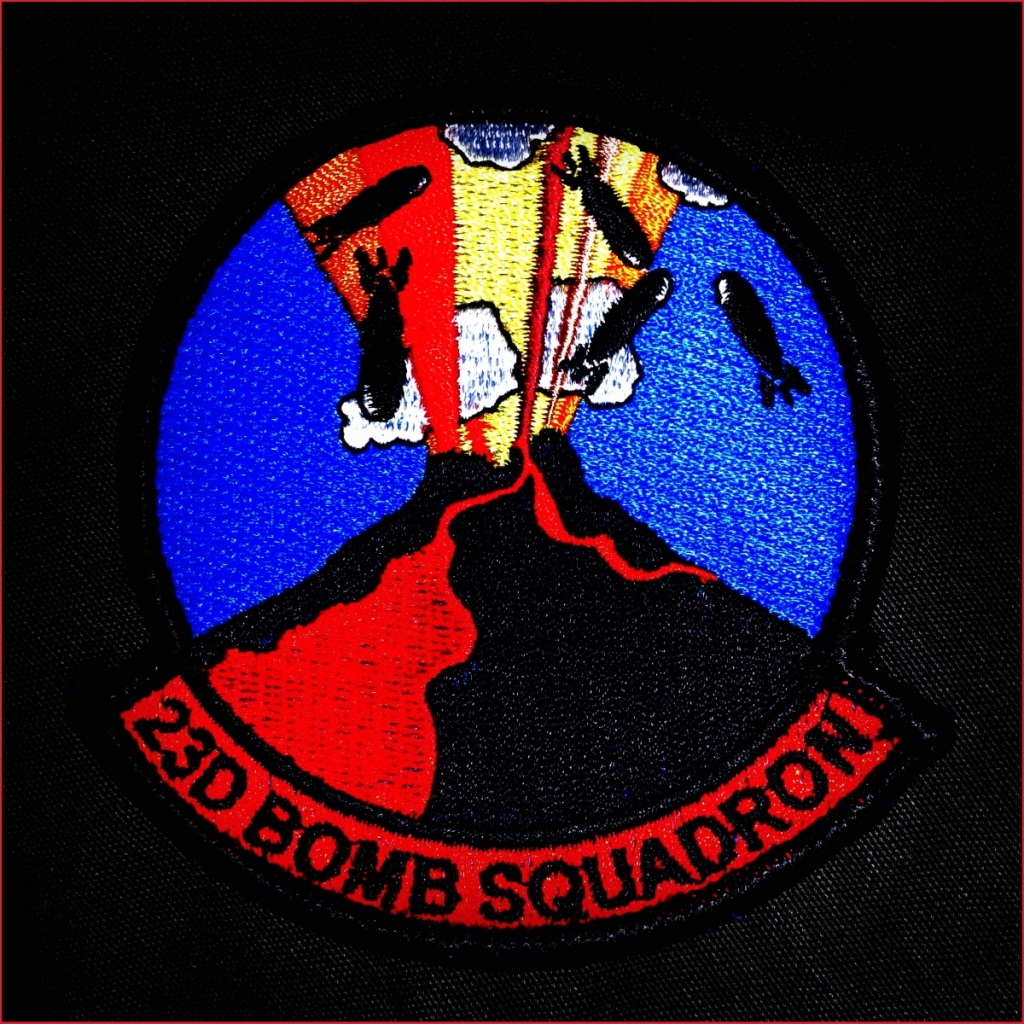
Current 23rd Bomb Squadron embroidered patch worn by B-52 crew.
July 1968 also witnessed the 23rd Bomb squadron move from Travis AFB, to Minot Air Force Base, North Dakota, where it abosrbed all the assets of the disbanded 720th bomb Squadron, which included personnel, equipment and B-52H bombers. Since this time, the 23rd Bomb Squadron has continuously operated from Minot AFB and will continue to do so for the foreseeable future.
23rd Bomb Squadron ‘Bomber Barons’, Anderson AFB Guam 2019 Deployment Leather patch.
During the 2019 Australian International Airshow, Aviation Spotters Online was afforded the rare privilege of having the opportunity to film a walk around with one of the 23rd Bomb Squadron crew members, who explained some of the key features of the aircraft, but also some Squadron history. Included in the vision is the arrival and departure of 60-0007 and the flyover during the Friday night show with 60-0060.
Since the first B-52H Stratofortress arrived at Avalon for the 1999 Australian International Airshow, there have been many visits and flyovers. Here’s a summary of the B-52 participants over the years –
1999 Australian International Airshow

Boeing B-52H Stratofortress 60-0051 5thBW/23rdBS ‘Barons’ Minot AFB, ND. ‘Appetite For Destruction II’ nose art. Seen here on static display at the 1999 Australian International Airshow. Image credit John Sise.
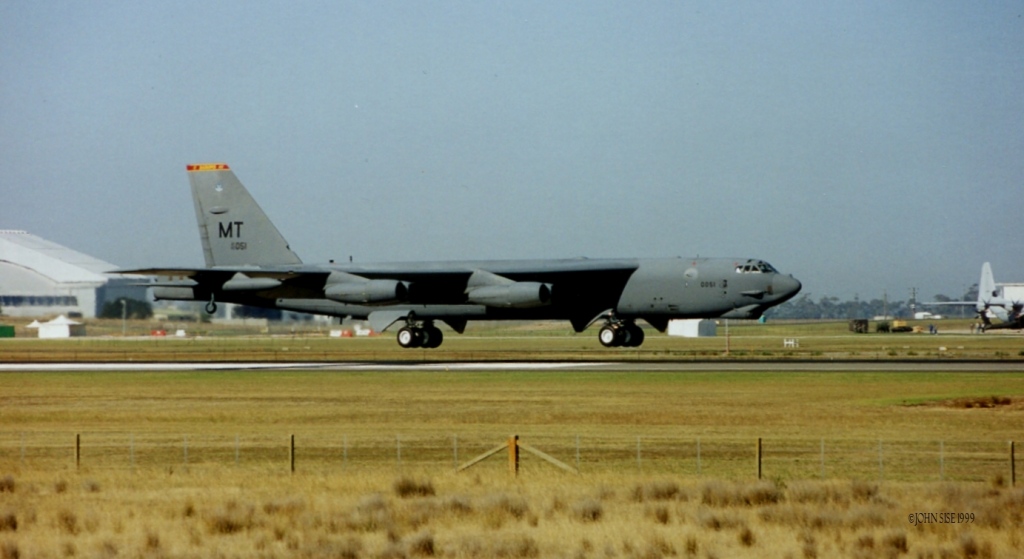
B-52H 60-0051 moments away from creating history as the first BUFF to touchdown at Avalon Airport, 1999. Image credit John Sise.
2001 Australian International Airshow
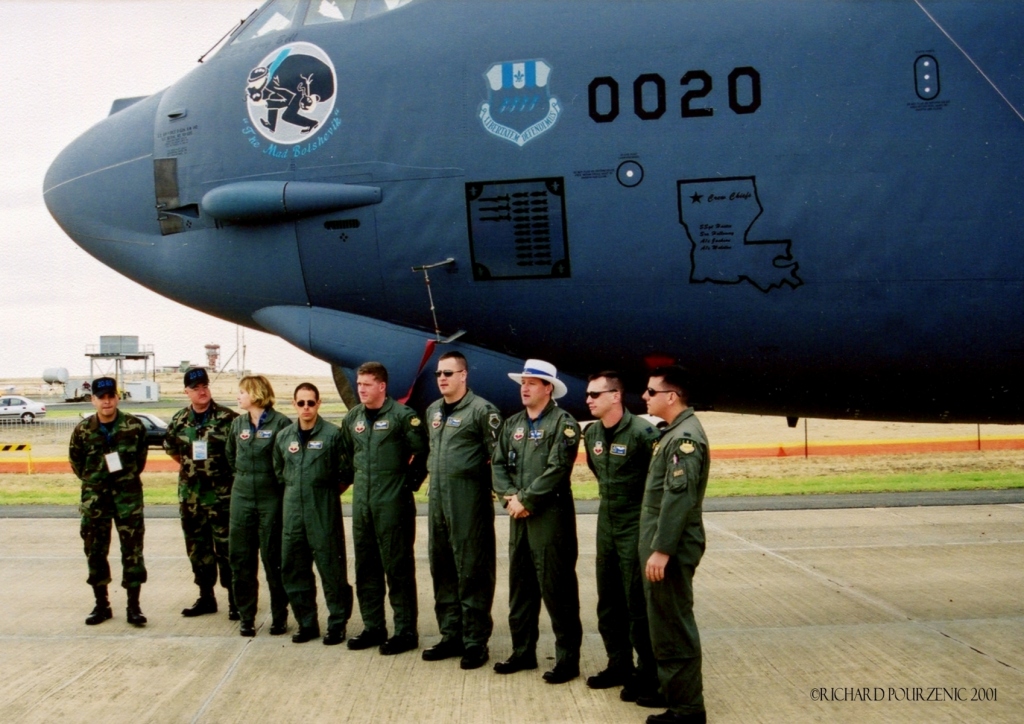
Boeing B-52H 60-0020 2ndBW/20thBS ‘Buccaneers’ Barksdale AFB, Louisiana, featuring ‘The Mad Bolshevik’ nose art. During the early years of the Australian International Airshow, one could purchase a Photographers Pass which gave one amazing opportunities such as ‘meet and greets’ with local and visiting aircrew, as seen here. Image credit Richard Pourzenic.
2005 Australian International Airshow
During the 2005 Australian International Airshow held at Avalon Airport, crowds were treated to a flyover on the Friday by 2ndBW/20thBs B-52 60-0012 ‘Havoc 18’, followed by another 2ndBW/20thBS ‘Buccaneers’ BUFF, 60-0032 on the Sunday, ‘Havoc 20’.
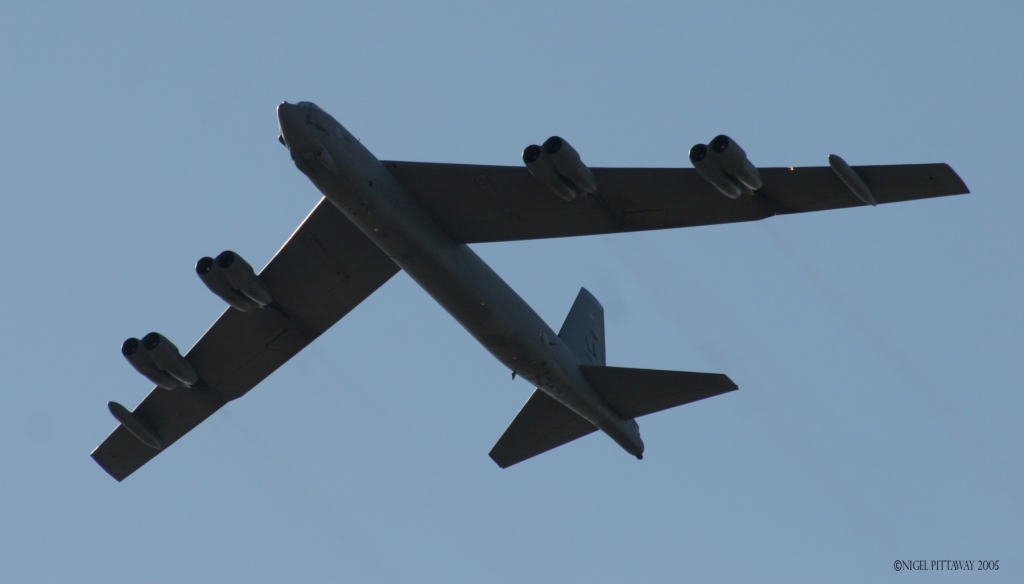
B-25H Stratofortress 60-0012 2ndBW/20thBS ‘Buccaneers’ overflying the 2005 Australian International Airshow. Image credit Nigel Pittaway.
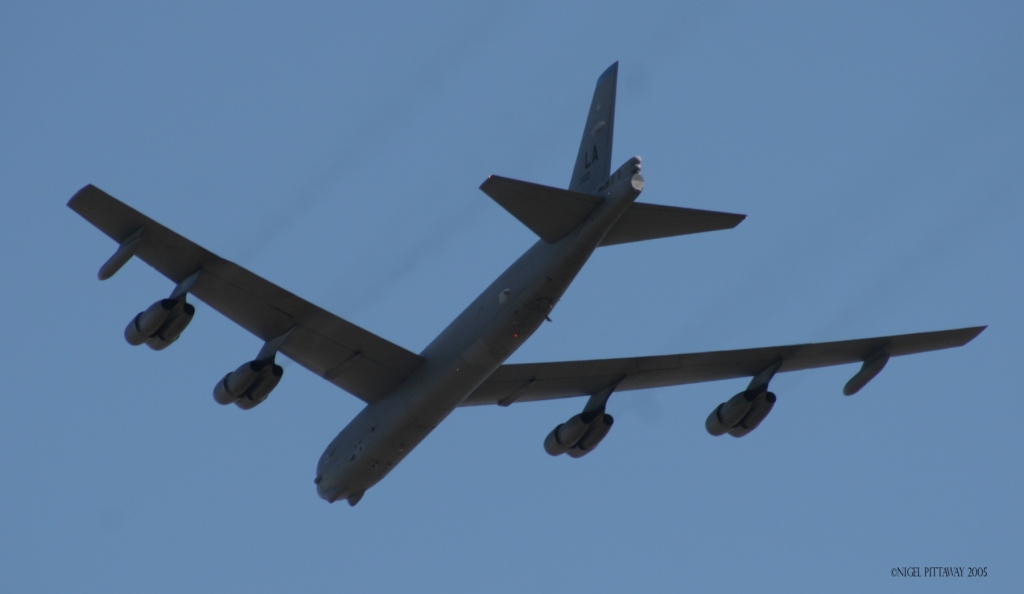
B-52H 60-0012 2ndBW/20thBS call sign ‘Havoc 18’. Friday March 18 2005, Image credit Nigel Pittaway.
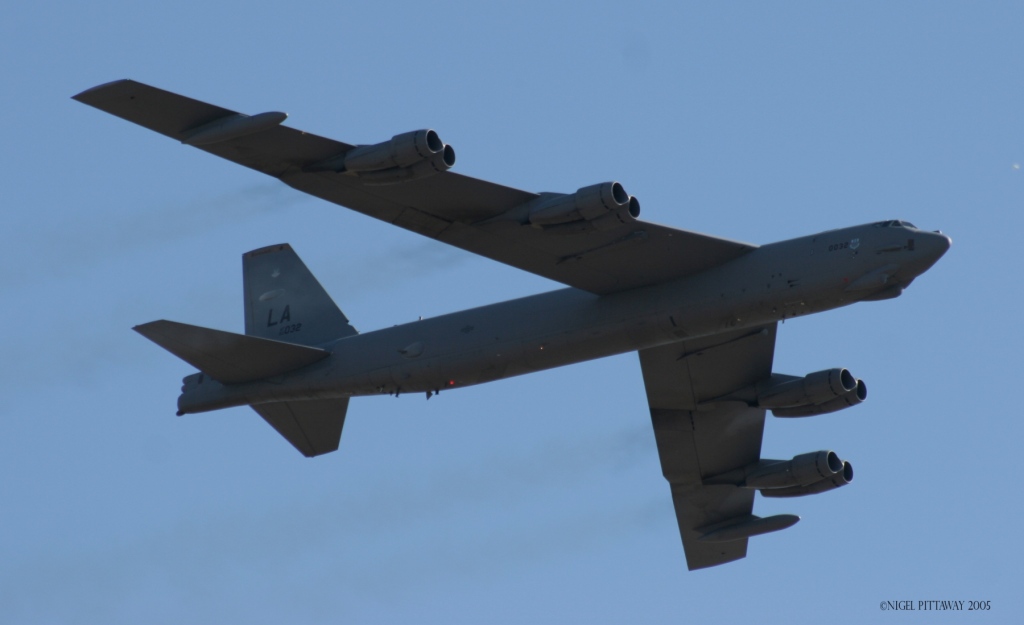
Boeing B-52H Stratofortress 60-0032 2ndBW/20thBS ‘Buccaneers’, call sign ‘Havoc 20’, overflying the Sunday crowd during the 2005 Australian International Airshow Image credit Nigel Pittaway.
2007 Australian International Airshow
Boeing B-52H Stratofortress 60-0030 2ndBW/20thBS ‘Buccaneers’ Barksdale AFB, Louisiana. Call sign ‘Havoc 93’ performing flyover during the Friday night alight show.

Boeing B-52H Stratofortress 60-0030 2nd Bomb Wing / 20th Bomb Squadron ‘Buccaneers’ during the 2007 Australian International Airshow, Image credit Nigel Pittaway.
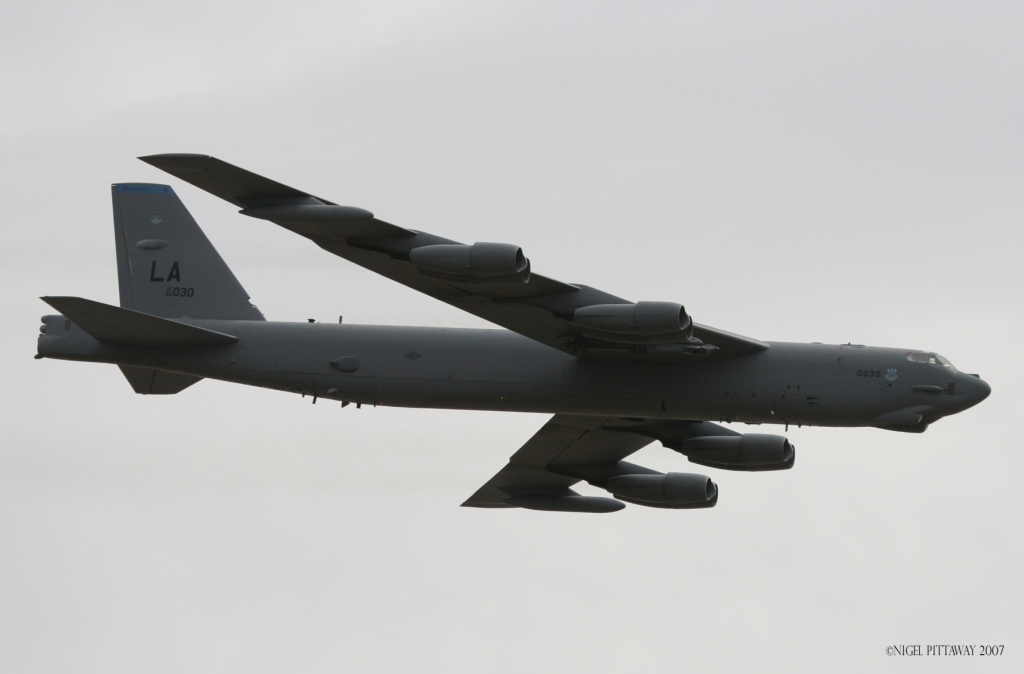
B-52H Stratofortress 60-0030, 2ndBW/20thBS ‘Buccaneers’ call sign ‘Havoc 93’, 2007 Australian International Airshow, Image credit Nigel Pittaway.
2011 Australian International Airshow
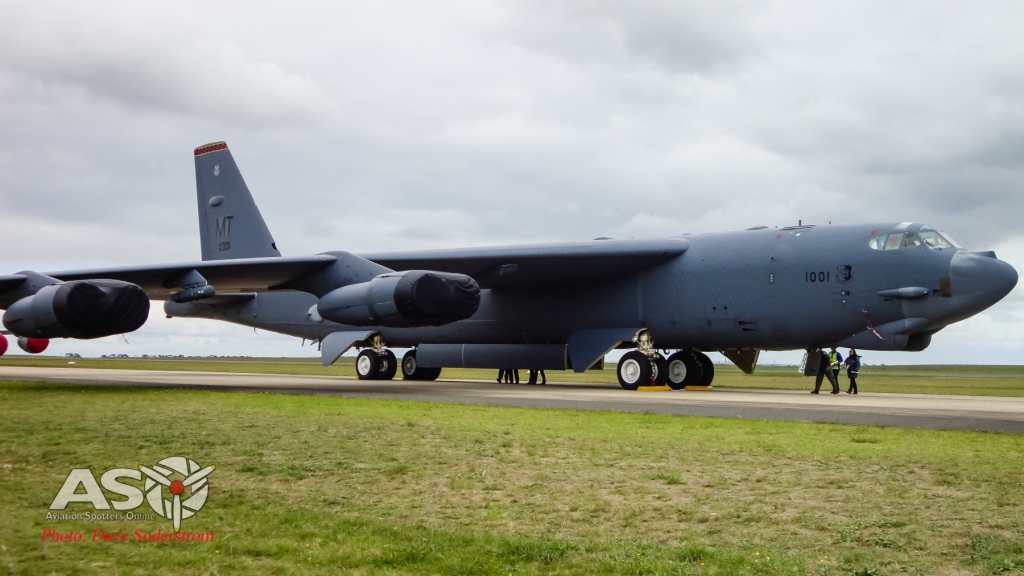
Boeing B-52H Stratofortress 61-0001 5th Bomb Wing / 23rd Bomb Squadron ‘Barons’ Minot Air Force Base, North Dakota. 2011 Australian International Airshow.

MT tail code and red/black checker fin flash signifying this B-52H is a 5th bomb Wing bird from the 23rd Bomb Squadron ‘Bomber Barons’. Avalon 2011.
2013 Australian International Airshow

Boeing B-52H Stratofortress 61-0012 2nd Bomb Wing/96th Expeditionary Bomb Squadron ‘Red Devils’ Barksdale AFB, Louisiana.

B-52H 61-0012 2ndBW/96thEBS ‘Loko’ Nose art 2013 Australian International Airshow.
2015 Australian International Airshow
Boeing B-52H Stratofortress 60-0002 2ndBW/20thBS ‘Buccaneers’, Barksdale AFB, Louisiana, that performed the weekend flyover.

B-52H 60-0002 2ndBW/20thBS overflying Avalon airport during the 2015 Australian International Airshow.
Boeing B-52H Stratofortress 61-0015 2ndBW/96thBS ‘Red Devils’, Barksdale AFB, LA seen here on arrival for static display.
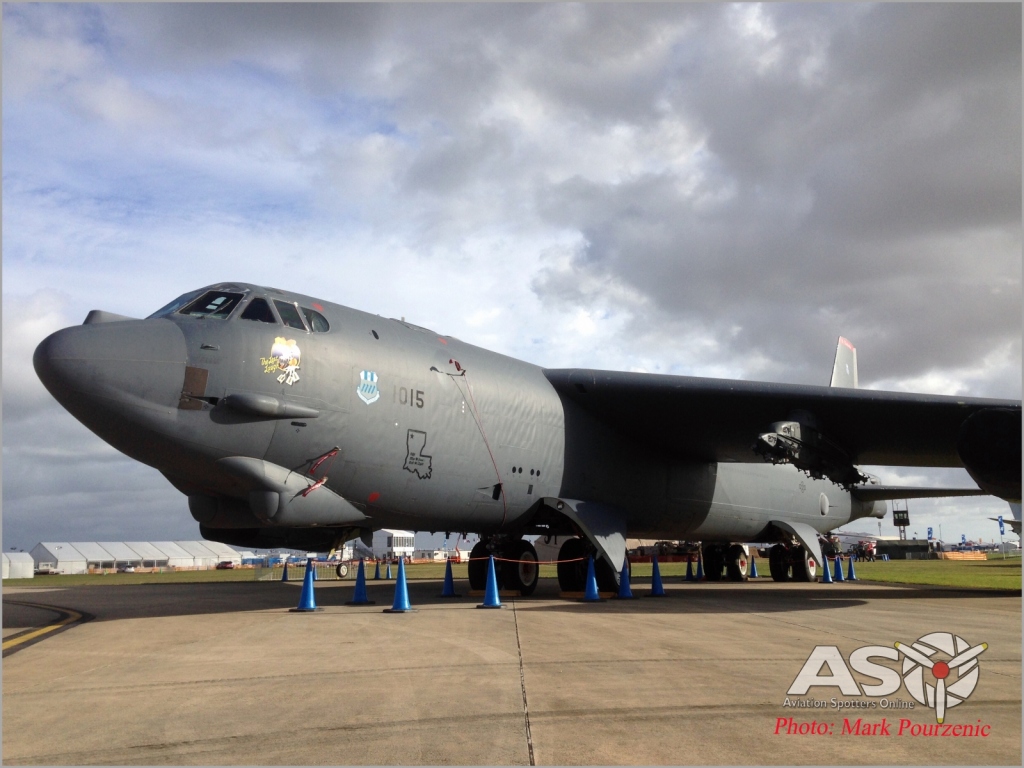
B-52H 61-0015 2ndBW/96thBS ‘Red Devils’ LA tail code.

‘The Last Laugh’ nose art on this 2ndBW/96th Bomb Squadron B-52H Stratofortress as seen at the 2015 Australian International Airshow.
Aviation Spotters Online would like to thank the United States Air Force, and the Airshows Downunder media team for their help and assistance for the opportunity to film the crew with their B-52. Would also like to take the time to once more, give a big thank you to the USAF B-52 airman for giving up his time, and for his sterling effort during filming of the featured vision.
Thank you
Mark Pourzenic

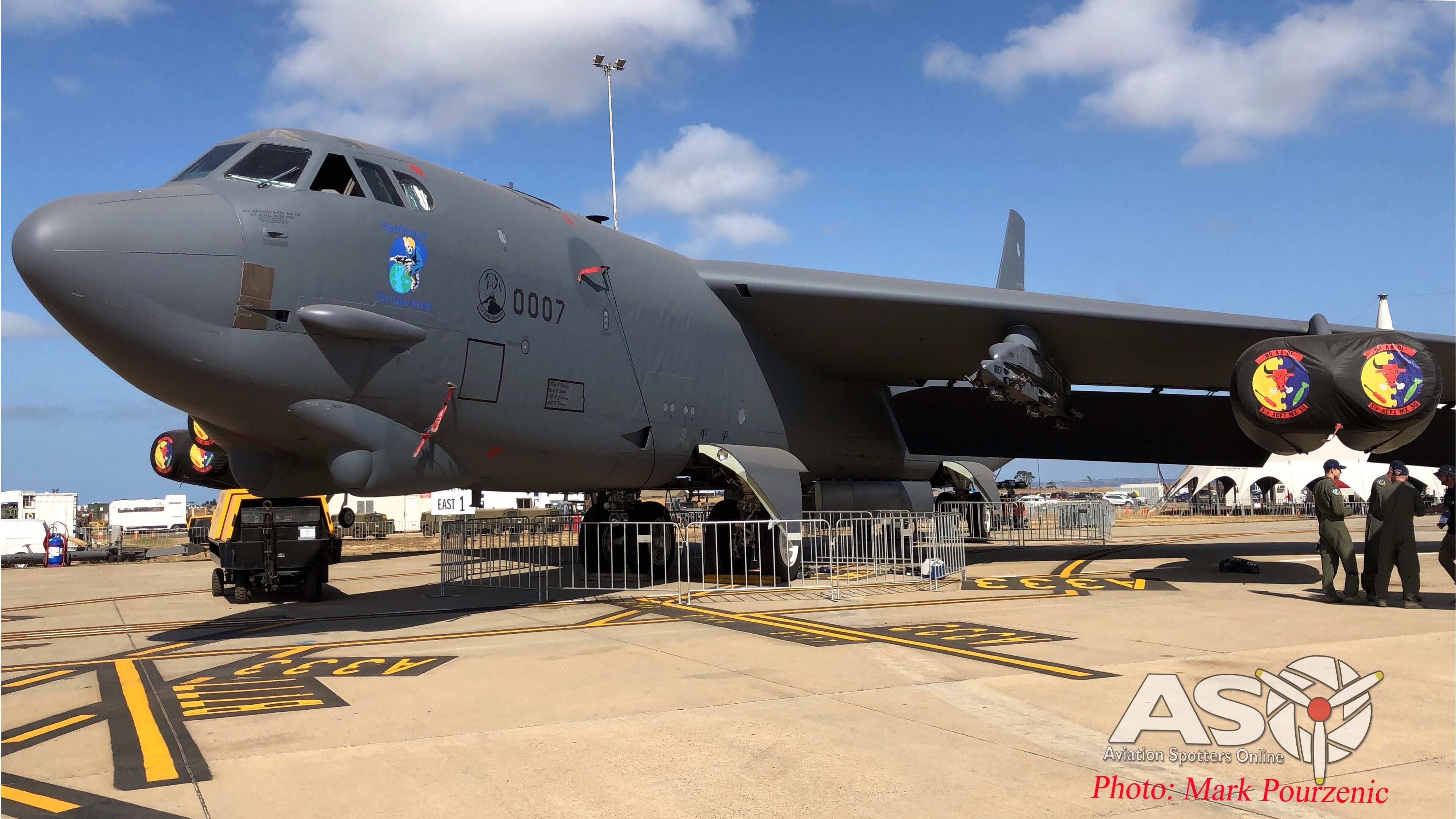



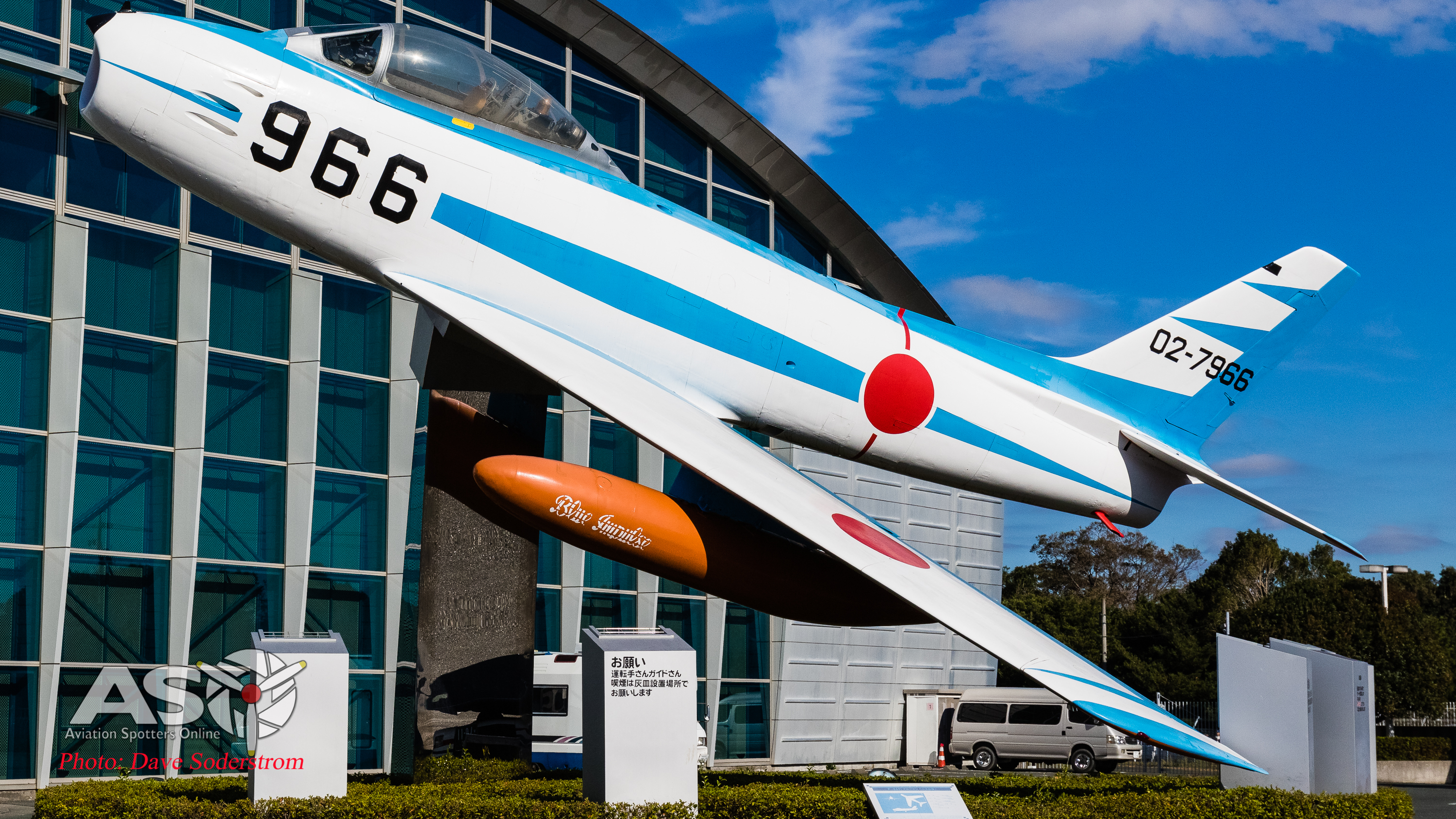





There were a couple of new attractions to the Airshow, one being a display from the Royal Singapore Air Force Black Knights, who performed a great two-ship routine comprising of a selection of formation and opposition manoeuvres. Avalon was one of only two international shows the team displayed at in 2015. The Australian Defence Force (ADF) also performed an airfield attack with the ARH Tigers and the MRH90 Taipan. 2015 was the first time they flew during the Avalon airshow.